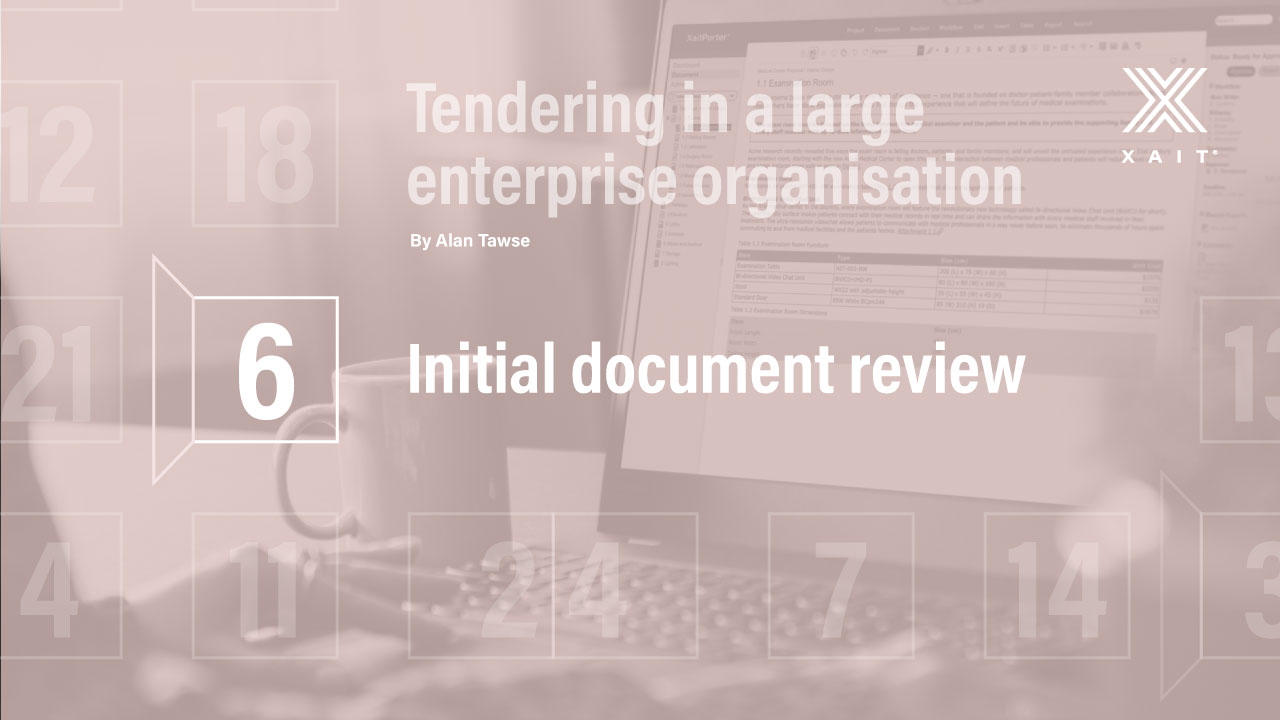
Initial document review
05.12.2020
-4 min

Software
LET'S TALK!
We offer software that makes you win big and ultimately gives you the work-life balance you deserve.

XaitPorter
Co-authoring and automation solution for complex documents

XaitCPQ
Quickly and accurately price combinations of interdependent products and services
XaitProposal
Guided proposal creation for comprehensive, winning proposals
XaitRFI
The smarter way to respond to RFIs, DDQs and security questionnaires
XaitWebProposal
The easiest way to create interactive and custom mini-websites

XaitAI
The X factor for analyzing and writing winning bids and proposals
Industry
OUR SOLUTIONS BY INDUSTRY
Do you have a question about your business vertical?
Resources
RESOURCES
Discover all our Xaiting resources!
About us
LET'S TALK
We can challenge mindsets and make significant changes to the way people interact

Alan Tawse
05.12.2020
-4 min

The next step for the tender support person or team is to review the documentation. For tender documents issued in hard-copy, this is straightforward – just a case of reading through the document package.
Where tender documents are issued electronically, the individual documents may not be organized in the way in which they are meant to be read, and may be just a collection of files sorted by file name. If so, then the files should be sorted into the intended order as best as possible. This can often be done by reviewing the actual documents and looking for a contents list, which can be used to determine the file order.
A simple method to organize files is to add a number prefix to the file name and adjust until the files display in the order they are to be read. It may be worth creating a sorted PDF copy of the entire inquiry, to make it simpler for others to review the parts they are interested in.
The person assigned to the tender support role will read through the tender documents to ascertain several key pieces of information.
It is also important to check the scope of work, as that has a bearing on who needs to participate in the tender response. So while reading through the tender documentation, the following aspects are included in this initial review:
It is likely that the tender support team will duplicate a set of the tender documents or files to use as their working copy during the tender process. They will retain the client originals in case additional copies are required by anyone else. This will allow the tender team to read through the tender and highlight relevant text, either on a paper copy or electronically with a color code, to separate out client questions, tender instructions, deliverables, etc.
Note that this should only be performed on a separate working copy, not on original documents or files. The highlighted copy will help with some of the administrative work that lies ahead, such as preparing information for the kickoff meeting, setting up the response, assigning tasks and compiling the final submission.
Once the tender document review is completed, the tender support person will if relevant share the information with whomever is the lead person for the tender response, so that the relevant persons in the bidder's organization can be identified. They will form the tender response team and work together to prepare the information to be submitted.
Where the bidder has been planning for a tender, it is likely that they will have already identified the key members of the tender response team. If so, it may still need to be adjusted if the scope of work differs from what was expected, or if some of the team members are unavailable during the period of compiling the tender response.
The goal is to identify the core team of persons expected to be involved in preparing the tender response, and is likely to include any or all the following roles:

Alan Tawse
Alan has worked in the oil and gas industry since 1974 in various administrative, operational and managerial roles in the UK, Netherlands and Norway. In 1993 he joined Halliburton in Norway as country manager of their new Drilling Systems division. Following a merger with Dresser industries in 1998, he moved to Business Development where he established a BD support team providing centralised expertise for tendering, contract management, market intelligence and various BD software systems. After managing up to 200 tenders and proposals annually for over 20 years, Alan retired at the beginning of 2020 with plans to explore Norway, and spend time with family overseas, He enjoys downhill skiing in the winter, golfing in the summer and following the Formula 1 racing season throughout the year.

